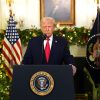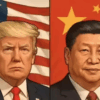In a fiery early-morning phone call with NBC News on March 30, 2025, President Donald Trump didn’t hold back his frustration with Russian President Vladimir Putin. “I’m very angry,” Trump declared, adding that he’s “pissed off” over Putin’s recent actions and words regarding the ongoing war in Ukraine. The tension stems from Putin’s criticism of Ukrainian President Volodymyr Zelenskyy and his call for a transitional government in Ukraine—a move that could shove Zelenskyy out of power. Trump isn’t having it, and he’s threatening to hit Russia where it hurts: its oil exports.
A Tariff Ultimatum
Trump laid out a clear warning: if he decides Russia is to blame for stalling a ceasefire with Ukraine, he’s ready to slap “secondary tariffs” on Russian oil. “If Russia and I are unable to make a deal on stopping the bloodshed in Ukraine, and if I think it was Russia’s fault—which it might not be—but if I think it was Russia’s fault, I am going to put secondary tariffs on oil, on all oil coming out of Russia,” he told NBC’s Kristen Welker. These tariffs, ranging from 25% to 50%, would target any country buying Russian oil, effectively barring them from doing business in the U.S. Trump promised action within a month if no deal is reached.
This isn’t the first time Trump has floated such a strategy. He recently announced similar “secondary tariffs” on nations buying oil and gas from Venezuela via his Truth Social platform. Countries like China, Turkey, Brazil, and India—some of the biggest importers of Russian oil—could feel the squeeze if Trump follows through.
Why the Anger?
Trump’s rage flared after Putin suggested Ukraine needs new leadership, a jab at Zelenskyy that Trump called out as going in the “wrong direction” for peace talks. Speaking to reporters aboard Air Force One, Trump expressed disappointment in Putin, saying, “He’s supposed to be making a deal with him, whether you like him or you don’t like him.” Yet, Trump’s own relationship with Zelenskyy has been rocky. He’s previously bashed the Ukrainian leader, falsely labeling him a “dictator” and criticizing his war management, even as he pushes for an end to the conflict.
The war in Ukraine has been a top priority for Trump since his campaign days, when he boldly claimed he could end it in 24 hours—a promise he later admitted was “a little bit sarcastic.” Still, his administration has made strides, brokering a partial ceasefire last week that ensures safe navigation in the Black Sea and halts attacks on energy infrastructure. But Putin’s latest comments have thrown a wrench into the fragile progress, and Trump’s patience is wearing thin.
Oil and Power Plays
Russian oil is already a rare sight in the U.S., thanks to President Joe Biden’s 2022 ban on imports following Russia’s invasion of Ukraine. In 2023, the U.S. imported just 10,000 barrels of Russian crude and petroleum products, a steep drop from previous years, according to the U.S. Energy Information Administration. Trump’s proposed tariffs would instead target Russia’s global oil trade, pressuring nations reliant on its exports to pick a side.
Despite his threats, Trump insists he has “a very good relationship” with Putin and believes his anger could “dissipate quickly” if the Russian leader “does the right thing.” The two are set to talk again this week, a sign that Trump hasn’t given up on diplomacy—yet.
A Broader Strategy?
Trump’s tough talk isn’t limited to Russia. In a separate NBC interview, he threatened Iran with “bombing the likes of which they have never seen before” if it doesn’t negotiate over its nuclear program. “If they don’t make a deal, there will be bombing,” he warned, though he noted U.S. and Iranian officials are “talking.” This double-barreled approach—tariffs on Russia, military threats on Iran—shows Trump flexing his foreign policy muscle early in his second term.
Why It Matters
Ending the Ukraine war is more than a campaign promise for Trump—it’s a chance to cement a major foreign policy win. The conflict, which erupted in February 2022, has dragged on for years, and Trump’s team has been hustling to bring Russia and Ukraine to the table. Recent talks in Saudi Arabia secured that Black Sea ceasefire, but Putin’s insistence on sanction relief as a condition keeps the deal on shaky ground. Meanwhile, Trump’s spat with Zelenskyy over rare earth minerals and NATO ambitions has only complicated things.
For now, Trump’s anger at Putin is driving the headlines—and the policy. Whether it leads to tariffs, a breakthrough, or just more heated words remains to be seen. As he told Welker, “Putin knows I’m angry.” The world’s watching to see what happens next.








